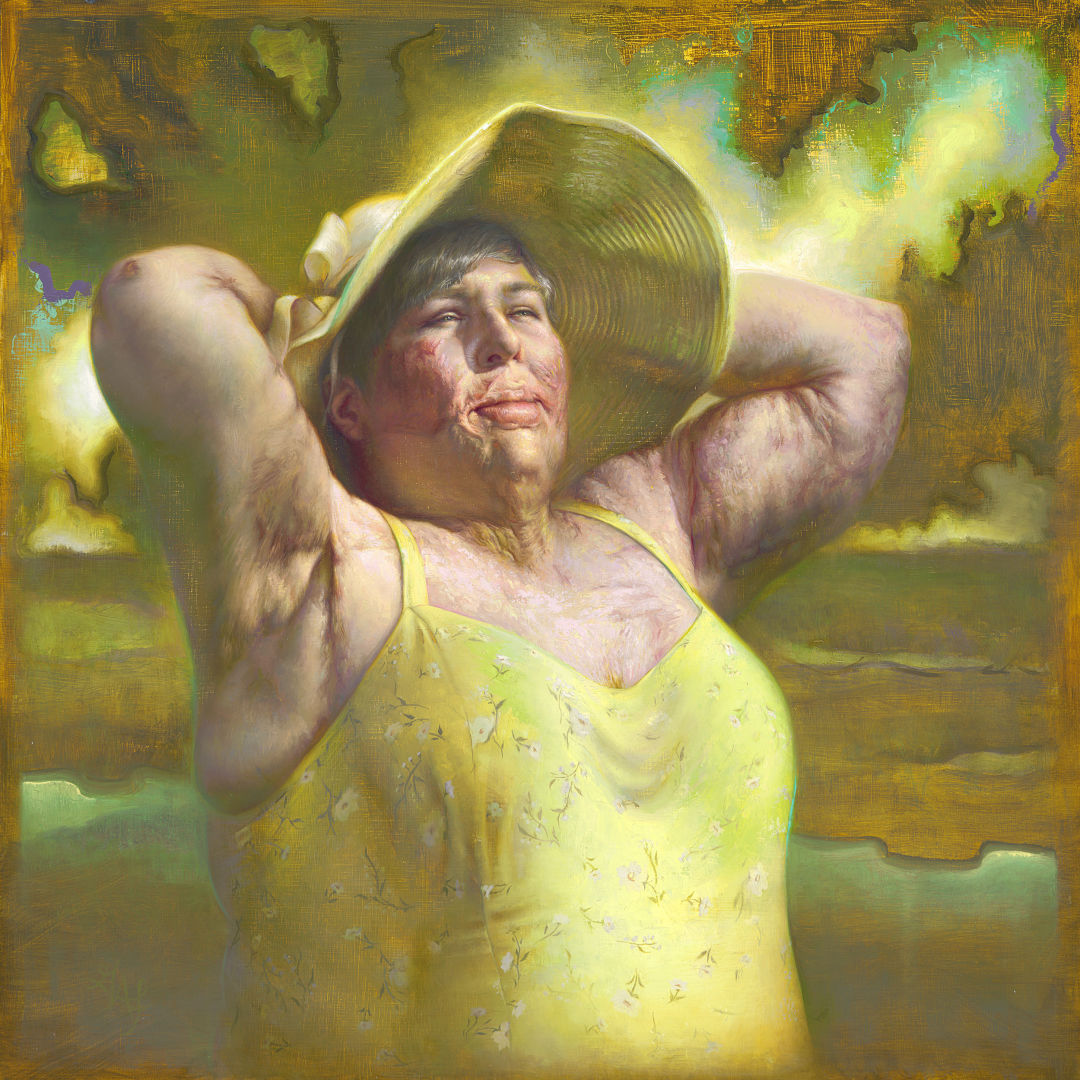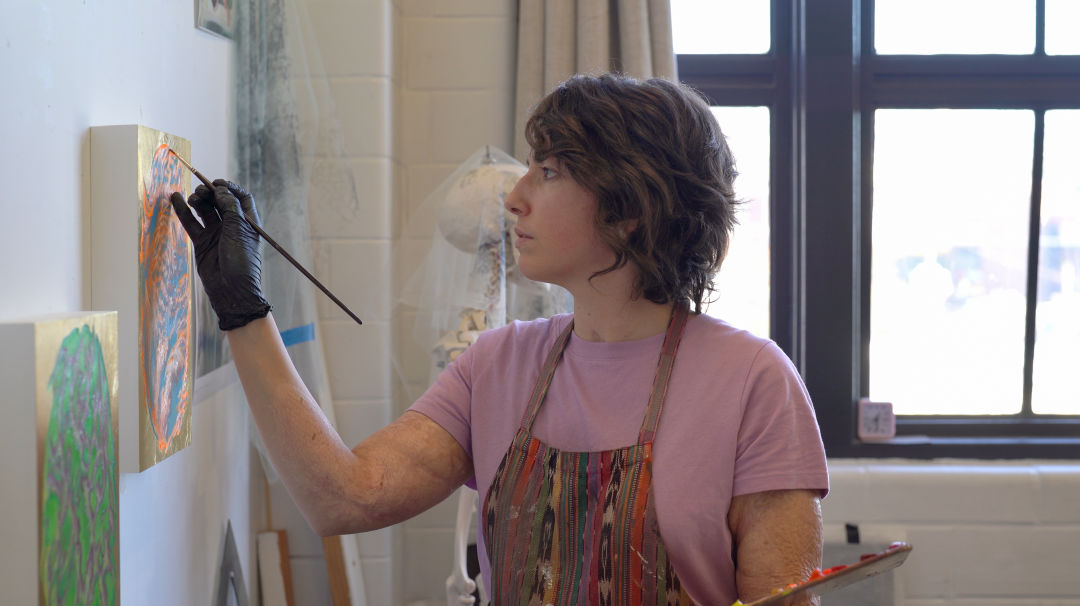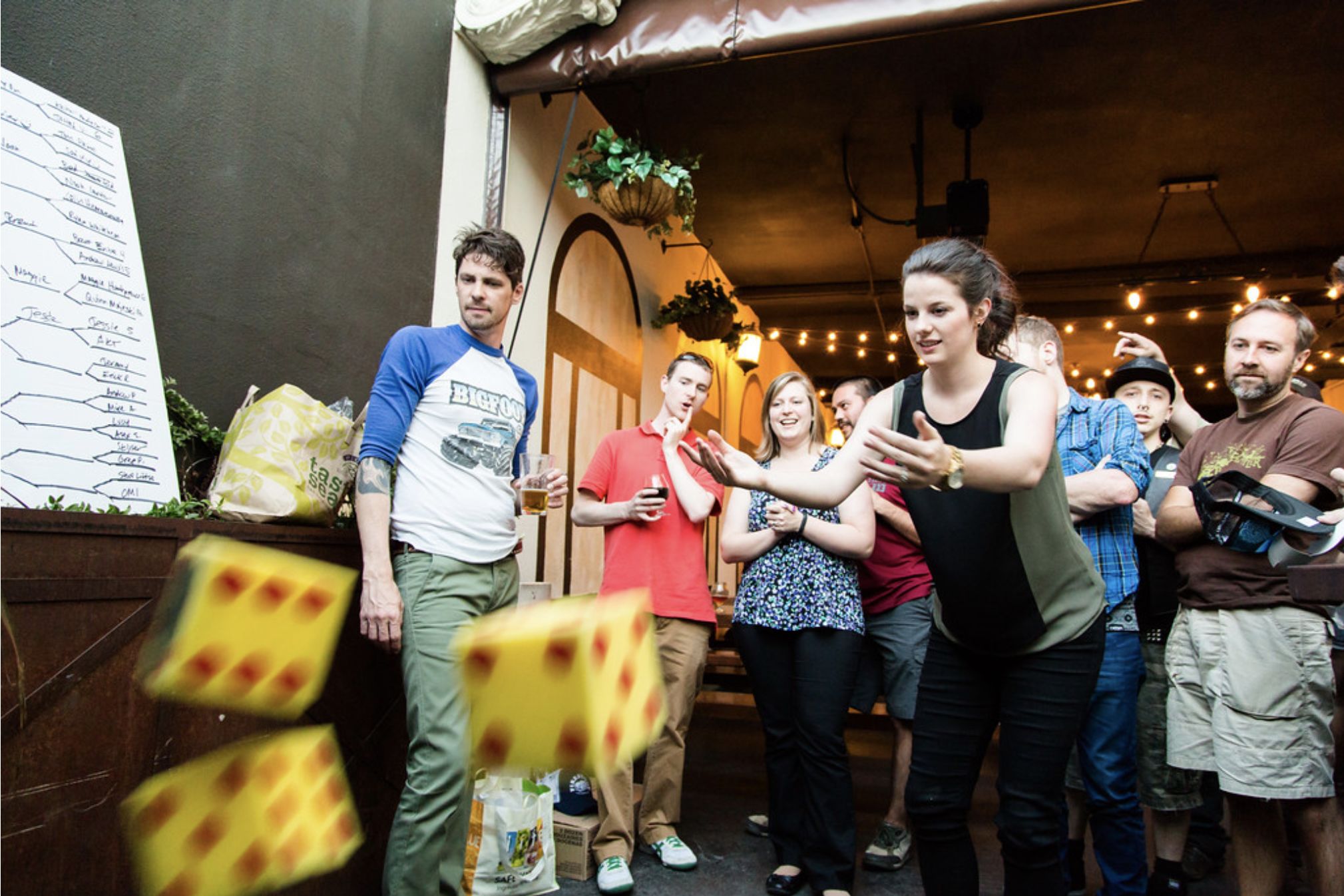Grace Athena Flott’s Portraits Celebrate Burn Survivors

Grace Flott's New Icons exhibit is on display at Pier 69.
When Grace Athena Flott was first searching for a venue to exhibit her portraits of burn survivors, she received the same response over and over.
“Oh, that would look good in a hospital,” people told her.
Flott understood where these comments came from. A burn survivor herself, she’d spent quite a bit of time in recovery spaces over the years.
But the art world was her world, too. The Capitol Hill resident had shown work in galleries around the city and country. She didn’t want these portraits, directly and indirectly depicting burn scars, stashed away in the bowels of drab medical facilities, far from the public eye. She wanted people to face them.
With a Hope Corps grant from the City of Seattle’s Office of Arts and Culture in her back pocket, Flott eventually found a venue—the Museum of Museums—that planned to display her work in October. Then in August, like everyone else, she learned that the First Hill art center would be shutting down for good due to plumbing problems.

Let it Shine (Portrait of Kari) 2022 Oil on aluminum panel 26 x 26 inches.
The impending closure set off a scramble that led to Flott’s New Icons exhibit landing at the Hologram Gallery in Pioneer Square last month, where about 450 people attended the 12-painting show’s opening, and, later, at the Port of Seattle’s Pier 69, where it remains on view through the end of February. With raised chins, defiant stares, and popping palettes, the portraits along the waterfront portray a group that is underrepresented in portraiture—and misrepresented in popular culture—in a new, celebratory light.
In 2011, Flott was studying abroad in Paris as an undergraduate at the University of Washington when an apartment fire nearly suffocated her. Hustling to a fourth-story window, Flott decided to jump. She broke her back and ankle from the fall and suffered second and third-degree burns across half of her body. Two of her friends died.
In many media accounts, Flott has found, that would be the end of her or any other burn survivor’s story—a human being reduced to a gruesome injury. But most survivors, she says, will ultimately recover. It’s the stigma tied to their physical differences and disfigurement that lingers.
“They’re getting…invasive questions, staring, outright harassment. It can get really serious, and there’s a lot of focus on that,” she says, noting she’s endured the same. “So I just wanted to be like, well, what else is going on for you? Can we celebrate this? Can we also notice how people are resilient?”
As she reckoned with her own scars, Flott sought out examples of burn survivors in art and popular culture. It’s not a small group; the CDC estimates more than 400,000 annual visits to emergency rooms in the U.S. for burns of varying degrees. Yet Flott found few representations that captured the complexity of living with burn injuries. “There was really nothing out there except horror movies, trauma porn in media, medical textbooks,” she says. “If you don’t see yourself, it’s like you’re erased.”
Eventually, after re-learning how to walk and graduating from UW, Flott decided that art could be a way for her to process her own case of identity disruption. The former labor organizer enrolled in a series of classical drawing and oil painting classes at the Gage Academy of Art in 2016. She wasn’t sure she’d complete the program when she started. But by time she finished in 2019, she believed she could create the images she wanted to see in the world. “I have painted myself plenty of times, which I realized opens up a new way of seeing my own body,” she says, “so I wanted to be able to give part of that experience to other people.”
That year she started making portraits of burn survivors, calling on her network for volunteer models. She’d ingrained herself in burn survivor spaces like Camp Eyabsut, serving as a counselor at the week-long camp for burn-injured youth in the Cascades. Still, she knew participating would require vulnerability and bravery; some of her fellow survivors hadn’t been photographed since their injuries.

Flott's paintings include both portraits of burn survivors, and abstract pieces mapping the patterns of their scars.
Image: courtesy Grace Flott
Flott gave each of them their reference photos to review and inquire about other artistic choices they’d like to see made to reflect their senses of self. “I think historically, when you’re talking about portraiture, it’s like, ‘I’m the artist, and I’m gonna take your portrait and do with it what I will. It’s my vision,’” she says. “So it’s pretty important to me that this is different, and the relationship is just more reciprocal.”
The back and forth wasn’t always swift, and the painting part alone took 100 hours or so to complete for each work. But Flott appreciated getting to know her fellow survivors better. She recorded interviews with each and made them accessible via QR codes in the exhibit, focusing on the parts of their identity that often get overlooked when people fixate on their scars. At the same time, she also printed directly from scars. She inked the skin and applied paper before enlarging the patterns through digitization and screen printing them onto panels. Abstract mappings of her own burns’ “ridges and valleys and colors and weird topography” hang among all the life-size oil portraits.

Mirror (Body map #1) 2023 Oil on panel 14 x 11 inches.
Image: Photo courtesy of the Artist
Troy Smith’s is one of them. About two decades ago, the assistant director of Camp Eyabsut suffered severe burns to his face, hand, and leg. He was, as he put it in his interview with Flott, “in a bad place,” rarely venturing outside in the months after his injury. A doctor eventually recommended he visit Camp Eyabsut for the first time. The acceptance he received there, even from campers far his junior, allowed him to embrace his injury as part of his identity. Over the years, he’s reciprocated that support as he’s become a leader at the camp. Flott’s portrait positions him in the clouds, their warmth dialed up, his smile wide as he places a hand over his heart. Smith feels Flott captured his essence. “I always say my heart is bigger than my body.”
Flott, meanwhile, wants her creative work to continue expanding our notion of beauty. She views beauty as truth, textured and multilayered, not as some idealized human form. Taking this approach has helped her view herself differently, and she hopes her portraits will do the same for other survivors, too.
“It’s different than just looking in the mirror or looking at yourself,” she says. “When you can see yourself as a work of art, it changes the way that you think about who you are.”




